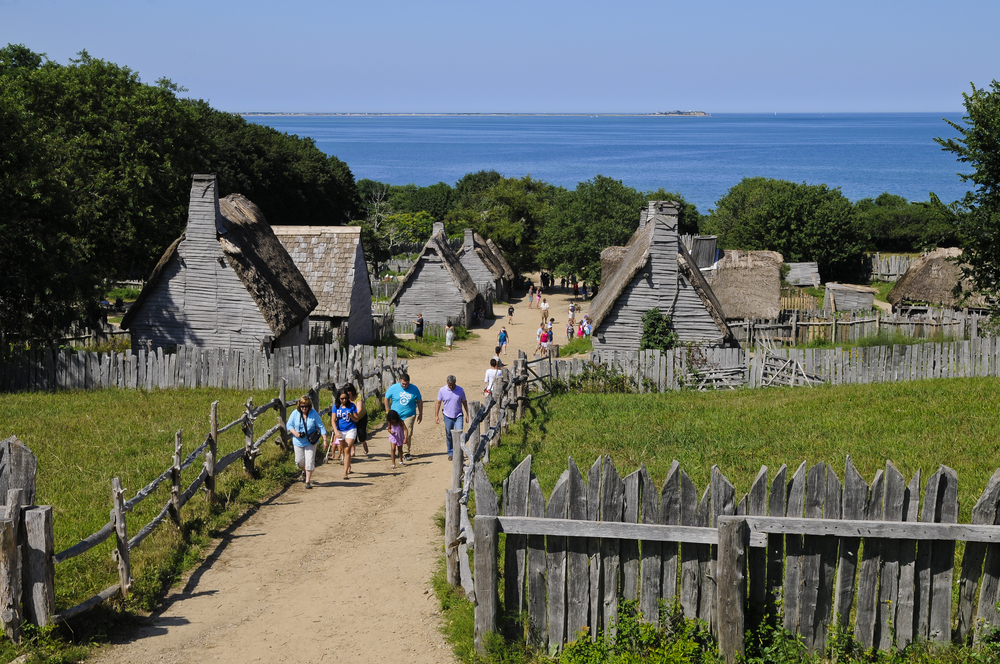

- Contact Us
- Search
-
Mayflower400 partner destinations:
Challenging perceptions of Wampanoag culture
The Wampanoag People have inhabited present-day Massachusetts and Eastern Rhode Island for thousands of years.
One of the areas was known as Patuxet, which means 'place with little waterfalls'. This area is known as Plymouth today.
Those who visit Patuxet today will encounter the Wampanoag Homesite, which is located along the banks of the Eel River.
Here, you will discover how 17th-century Wampanoag People would have lived along the coast during the growing season.
How they would have planted their crops, fishing and hunting, gathering wild herbs and berries for food, and reeds for making mats and baskets.
The Homesite sits close to the 17th-century English Village, a re-creation of the small farming and maritime community built by the Pilgrims along the shore of Plymouth Harbor.
However, unlike the people you'll meet in the English Village, the staff in the Wampanoag Homesite are not role players.
They are all native people - either Wampanoag or from other native nations - all dressed in historically accurate clothing, mostly made of deerskin.
The staff there are very knowledgeable of the people who have lived in this region for more than 10,000 years.
They are also extremely proud of their Native heritage - none more so than Darius Coombs, Director of Wampanoag and Eastern Woodlands Research and Interpretive Training at Plimoth Patuxet.
Darius knows and appreciates the importance of keeping alive the traditions, stories, technology, pastimes, music and dance of his ancestors.
However, there is still much to do in educating people about Native American culture.
Here, Darius talks about his own experiences and challenging people's perceptions.
Educating people about the Wampanoag Nation
I went to school in Plymouth in the United States, and in the seventh grade we made a field trip to Plimoth Patuxet, but they never brought us to the Wampanoag Homesite.
We visited the Pilgrim village, and that was it. I didn't even know the Homesite existed until I came here.
Who works at Plimoth Patuxet?
We're a cultural programme which hires native indigenous people from south central North America, because we're all similar.
I live right in the community of Mashpee, being a Wampanoag community on Cape Cod which is still one of the oldest and biggest today.
All of my cousins come up to me at the country store and say, 'Hey, can't I work where you work?'
I look at them and say, 'Okay, I know you're good at making baskets and woodwork, but can you talk hundreds, if not thousands, of guests a day from all around the world about slavery, cultural genocide and colonisation without getting upset at the guests?'
They'll look at me like, 'I don't know if I can do that'.
And the reason they say that is because it's real for our people and it still hurts inside.
What are your experiences of Plimoth Patuxet?

How people come into the museum - especially when it comes down to the Wampanoag Homesite - how they're going to feel about us when they first come in, how they're going to leave, is a really big thing.
We want them to come in thinking one way and leaving thinking another way.
What they know about native people in general is what they see on TV in old movies and such, which is not accurate.
They portray a lot of native people from out west as going around on horses and killing people all the time.
Is it tough to change people's perceptions?
You often hear the terms 'warlike' and 'peaceful', which have always been stuck on native people.
You cannot describe any culture as 'warlike' and 'peaceful' - that's totally disrespectful.
But that's what people know about us, so when they come to the Wampanoag Homesite, a lot of the time they don't know how to act.
You see them walking on eggshells and not sure what to say - you can just read their faces.
What we do encourage people to do is ask lots of questions. Often, they are very surprised at how much they learn.
Sign up for the latest Mayflower 400 news
You'll be the first to hear the latest Mayflower news, events, and more.
Log In
Register
Mayflower 400 Proudly Supported by our National Sponsors and Funding Partners






